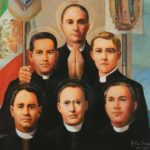
Knights of Columbus Mexican Priest Martyrs’ Award of Service
These six priests were martyred for their faith during a time of turmoil in Mexico when Catholics were being persecuted. All of them died because they chose to continue to serve their people despite the threat of death. We want to honor their sacrifice by creating an award in their name that will be given out during the year to the chaplains in California who give of themselves not only to their parish and diocese but also to the Knights as a chaplain. The Knights of Columbus are forever thankful for the dedicated priests who not only serve their parish or community but who also take the time to serve the Knights of Columbus as chaplains.
The Knights want to honor and thank those dedicated priests for their service throughout the Columbian Year. Each month beginning in September 2019 through February 2020 we will honor the Knights of Columbus Chaplains who have displayed extraordinary service to their Council and Parish. These priests will automatically be considered for the yearly Fr. Juan Perez Award given out at the California State Convention.
- September: Luis Batis Mexican Martyr Award
- October: Rodrigo Aguilar Mexican Martyr Award
- November: Miguel de la Mora Mexican Martyr Award
- December: Pedro de Jesús Maldonado Mexican Martyr Award
- January: José María Robles Mexican Martyr Award
- February: Mateo Correa Mexican Martyr Award
Award Submission Process:
- Use the Mexican Martyrs’ Award Monthly Entry Form for submissions1
- Who Can Nominate? All councils, assemblies, chapters and Squire Circles in California
- Who is eligible to receive this award? Chaplains for councils, assemblies, chapters and Squire
- How many awards will be given out each month? All priests nominated will receive this This is not a competition but a recognition of dedication and service as a chaplain in the Knights of Columbus
- What is the deadline to apply? Deadline is the 15th of the month prior to the award month.
- Where is the nomination form? It is on the State Website under
- Where do I send the completed form? Email to:
Saint Augustine Zhao Rong
 The Martyred Saints of China, or Augustine Zhao Rong and his 119 companions are saints of the Roman Catholic Church that John Paul II canonized in 2000. They consisted of 87 Chinese Catholics, and 33 Western Missionaries from the mid-17th century to 1930. They were martyred because of being missionaries, and in some cases, for their refusal to apostatize. Many died in the Boxer Rebellion, in which xenophobic peasants slaughtered 30,000 Chinese converts to Christianity along with missionaries and other foreigners.
The Martyred Saints of China, or Augustine Zhao Rong and his 119 companions are saints of the Roman Catholic Church that John Paul II canonized in 2000. They consisted of 87 Chinese Catholics, and 33 Western Missionaries from the mid-17th century to 1930. They were martyred because of being missionaries, and in some cases, for their refusal to apostatize. Many died in the Boxer Rebellion, in which xenophobic peasants slaughtered 30,000 Chinese converts to Christianity along with missionaries and other foreigners.
Although Christianity had spread itself around the world by this time, it did not reach China until the 600’s, by way of Syria. Depending on China’s relations with the outside world, Christianity over the centuries was free to grow or was forced to operated secretly.
The 120 martyrs in this group all died between 1648 and 1930. Most of them born in China were children, parents, catechists or laborers, ranging from nine years old to age 72. This included four Chinese diocesan Priests. The 33 from the western world were mostly Priests or Women Religious, especially from the Order of Preachers, the Paris Foreign Mission Society, the Friars Minor, Jesuits, Salesians, and Franciscan Missionaries of Mary.
Augustine Zhao Rong was a Chinese Soldier, who accompanied Bishop John Gabriel Taurin Dufresse, a Paris Foreign Mission Society member, to his martyrdom in Beijing. Augustine was baptized and not long after was ordained as a diocesan Priest. He was martyred in 1815. Beatified in groups at various times, all 120 of these martyrs were canonized in Rome, on October 1st, 2000. The Church celebrates them on this Feast Day, July 9th.
Saint Lorenzo Ruiz
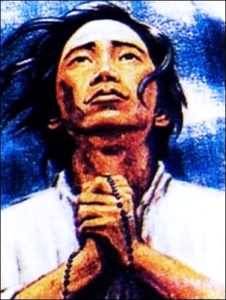 Lorenzo was born in Manila of a Chinese father and a Filipino mother, both Christians. He became a professional calligrapher, transcribing documents in beautiful penmanship. He was a full member of the Confraternity of the Holy Rosary under Dominican auspices. He married and had two sons and a daughter.
Lorenzo was born in Manila of a Chinese father and a Filipino mother, both Christians. He became a professional calligrapher, transcribing documents in beautiful penmanship. He was a full member of the Confraternity of the Holy Rosary under Dominican auspices. He married and had two sons and a daughter.
Lorenzo’s life took an abrupt turn when he was accused of murder. Nothing further is known except the statement of two Dominicans that “he was sought by the authorities on account of a homicide to which he was present or which was attributed to him.”
At that time, three Dominican priests, Antonio Gonzalez, Guillermo Courtet, and Miguel de Aozaraza, were about to sail to Japan in spite of a violent persecution there. With them was a Japanese priest, Vicente Shiwozuka de la Cruz, and a layman named Lazaro, a leper. Lorenzo, having taken asylum with them, was allowed to accompany them.
In Japan they were soon found out, arrested, and taken to Nagasaki. They were subjected to an unspeakable kind of torture: After huge quantities of water were forced down their throats, they were made to lie down. Long boards were placed on their stomachs and guards then stepped on the ends of the boards, forcing the water to spurt violently from mouth, nose and ears.
In Lorenzo’s moment of crisis, he asked the interpreter, “I would like to know if, by apostatizing, they will spare my life.” The interpreter was noncommittal, but in the ensuing hours Lorenzo felt his faith grow strong. He became bold, even audacious, with his interrogators.
In 1987, Pope John Paul II canonized Lorenzo and 15 others: Asians and Europeans, men and women, who spread the faith in the Philippines, Formosa, and Japan. Lorenzo Ruiz is the first canonized Filipino martyr.
Saint Andrew Dung-Lac
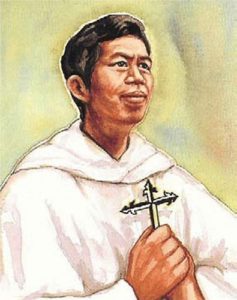 A Vietnamese diocesan priest who suffered martyrdom is *Andrew Dung-Lac, who is honored by being the representative of the 117 martyrs in the Roman Calendar.
A Vietnamese diocesan priest who suffered martyrdom is *Andrew Dung-Lac, who is honored by being the representative of the 117 martyrs in the Roman Calendar.
His name was originally Dung An Trân, and he was born about 1795 in a poor and pagan family in Bac-Ninh in North Vietnam. When he was twelve the family had to move to Hà-Nôi (Hanoi) where his parents could find work. There he met a catechist and got food and shelter from him. He also got education in Christian faith for three years, and was baptized in Vinh-Tri with the Christian name Andrew (Andrew Dung).
After learning Chinese and Latin he became a catechist, and thereafter taught catechises in the country. He was chosen to study theology, and on 15 March 1823 he was ordained priest. As parish priest in Ke-Dâm he was tireless in his preaching. He often fasted and lived a simple and moral life, he was a good example for the people, and many were baptized.
In 1835 he was imprisoned under emperor Minh-Mang’s persecutions (he was called Vietnam’s emperor Nero), but his freedom was purchased by donations from members of the congregation he served.
To avoid persecutions, he changed his name to Lac (Andrew Lac) and moved to another prefecture to continue his work. But on 10 November 1839 he was again arrested, this time with Peter Thi, another Vietnamese priest whom he was visiting so that he might go to confession.
Once again Andrew was liberated, along with Peter Thi, in exchange for money. Their freedom was brief. They were soon re-arrested and taken to Hanoi, where both suffered a dreadful torture. Finally, they both were beheaded 21 December 1839. Andrew was beatified in the first group on 27 May 1900
History of the Knights of Columbus Priest Martyrs of Mexico in the early 20th century, the Mexican government began a widespread persecution of Catholics. In 1926, priests, missionaries and members of religious orders were expelled from the country. Ignoring the right to religious freedom, the government under President Plutarco Elías Calles took control of churches, seminaries, convents and schools, thereby beginning the campaign to do away with all the “fanatics” who professed their Catholic faith. In the face of violence and persecution, more than a million Mexicans migrated to the United States seeking refuge; others spontaneously organized to defend themselves against government oppression, some peacefully and others taking up arms under the banner of “Cristo Rey” (“Christ the King”). This was the beginning of what became known as the Cristiada or Cristero War. For three years (1926-1929), the Mexican people lived through violent persecution, in which priests and laypeople were ordered to renounce Christ in public. To refuse to do so meant facing not only punishment, but even torture and death. Thousands of Mexican Catholics gave witness to their faith or fought to defend it. In many cases, they paid for it with their lives. Their acts of love and bravery have echoed throughout the decades, and we remember their testimony today. Since its founding in Mexico in 1905, the Knights of Columbus had promoted and given witness to a vibrant understanding of Catholic citizenship. By the time of the 1924 Eucharistic Congress in Mexico City, there were already more than 50 K of C councils throughout the country — from Jiménez, Chihuahua, to Mérida, Yucatán. During the persecution, the Knights helped organize the League for the Defense of Religious Statue in memory of the Mexican Martyrs, Knights of Columbus Museum, New Haven, Conn. Liberty, which brought together and organized the country’s main Catholic institutions. The League worked to raise the nation’s consciousness and demanded that the Mexican government respect the rights of its citizens. In the United States, meanwhile, the Knights created a fund to aid the exiled and the migrants. In addition, they distributed five million flyers denouncing the brutality of the Mexican government toward Catholics. As a result, the Mexican government outlawed the Knights of Columbus and singled out its members for persecution. In his encyclical 1926 Inique Afflictisque, Pope Pius XI singled out the testimony and work of the Knights in Mexico: “A word of very special praise is due those Catholic organizations, which during all these trying times have stood like soldier’s side to side with the clergy. … First, we mention the Knights of Columbus, an organization which is found in all the states of the Republic and which fortunately is made up of active and industrious members who, because of their practical lives and open profession of the Faith, as well as by their zeal in assisting the Church, have brought great honor upon themselves.” In 1926, a delegation from the Order, headed by the Supreme Knight James A. Flaherty, met with U.S. President Calvin Coolidge and asked him to demand that Calles’ government put an end to religious persecution in Mexico. It wasn’t until 1929 that President Calles, through intervention from the U.S. ambassador Dwight Morrow, accepted the so-called agreements with Mexican bishops. The churches could go back to celebrating Mass, and those known as Cristeros, who had fought to defend their rights, surrendered their weapons. However, the government did not honor the agreements and continued to persecute Catholics in various degrees in the decades that followed. Finally, in 1992, the constitution was reformed giving legal recognition to religious associations in Mexico. Of the 25 Mexican martyrs whom Pope John Paul II canonized in 2000, six were members of the Knights of Columbus. Their stories are recounted below.
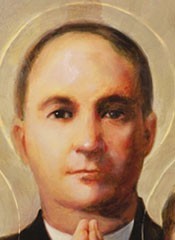 FATHER MIGUEL DE LA MORA DE LA MORA
FATHER MIGUEL DE LA MORA DE LA MORA
Father Miguel de la Mora de la Mora of Colima belonged to Council 2140. Along with several other priests, he publicly signed a letter opposing the anti-religious laws imposed by the government. He was soon arrested and, with his brother Regino looking on, Father de la Mora was executed without a trial by a single shot from a military officer as he prayed his rosary. It was Aug. 7, 1927.
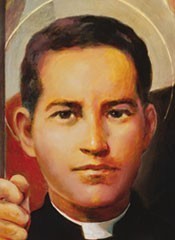 FATHER PEDRO DE JESUS MALDONADO LUCERO
FATHER PEDRO DE JESUS MALDONADO LUCERO
Father Pedro de Jesus Maldonado Lucero was a member of Council 2419. Forced to study for the priesthood in El Paso, Texas, because of the political situation in Mexico, he returned home after his ordination in 1918 despite the risk. Captured on Ash Wednesday, 1937, while distributing ashes to the faithful, Father Maldonado Lucero was so savagely beaten that one eye was forced from its socket. He died the next day at a local hospital. His tombstone aptly described this martyr in four words: “You are a priest.”
 FATHER JOSE MARIA ROBLES HURTADO
FATHER JOSE MARIA ROBLES HURTADO
Father Jose Maria Robles Hurtado was a member of Council 1979. Ordained in 1913, he founded the Sisters of the Sacred Heart of Jesus in Guadalajara when he was only 25. On June 25, 1927, he was arrested while preparing to celebrate Mass. Early the next morning, he was hanged from an oak tree, but not before he had forgiven his murderers and offered a prayer for his parish. He went so far as to place the rope around his own neck, so that none of his captors would hold the title of murderer
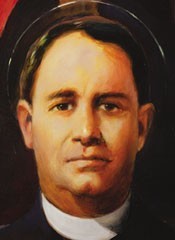 FATHER RODRIGO AGUILAR ALEMÁN
FATHER RODRIGO AGUILAR ALEMÁN
Father Rodrigo Aguilar Alemán of Union de Tula in Jalisco was a member of Council 2330. After a warrant was issued for is arrest, he took refuge at the Colegio de San Ignacio in Ejutla, celebrating Mass and administering the sacraments.
Rather than escape when soldiers arrived, Father Aguilar Alemán remained at the seminary to burn the list of seminary students, and thus protect them from being known. When the soldiers demanded his identity, he told them only that he was a priest.
He was taken to the main square of Ejutla, where the seminary was located. He publicly forgave his killers, and then a soldier gave him the chance to save himself by giving the “right” answer to this question, “Who lives?”
But he replied, “Christ the King and Our Lady of Guadalupe.” The noose that had been secured to a mango tree was tightened, then relaxed twice. Each time it was relaxed, he was asked the same question and each time he gave the same response. The third time the noose was tightened, he died.
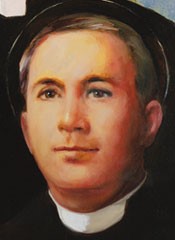 FATHER MATEO CORREA MAGALLANES
FATHER MATEO CORREA MAGALLANES
Father Mateo Correa Magallanes, who was a member of Council 2140, was arrested and taken to Durango. While in prison, he was ordered by the commanding officer on Feb. 5, 1927, to hear the confessions of his fellow prisoners. Then the commander demanded to know what they had told him. Of course, Father Correa Magallanes wouldn’t violate the seal of confession, and so, the next day, he was taken to a local cemetery and executed by the soldiers.
 FATHER LUIS BATIZ SAINZ
FATHER LUIS BATIZ SAINZ
Father Luis Batiz Sainz was born in 1870, and was a member of Council 2367. On Aug. 15, 1926, at Chalchihuites, Zacatecas, he and three layman – David Roldan, who was only 19 at the time, Salvador Lara and Manuel Morales – were put before a firing squad for refusing to submit to anti-religious laws. When Father Batiz Sainz asked the soldiers to free one of the captives, Manuel Morales, who had sons and daughters, Morales wouldn’t hear of it.
“I am dying for God,” he declared,” and God will care for my children.” Smiling, Father Batiz Sainz gave his friend absolution and said: “See you in heaven.”

